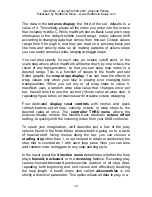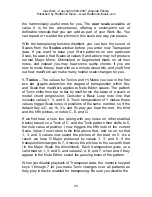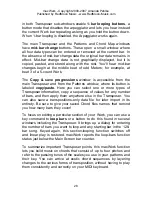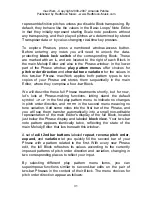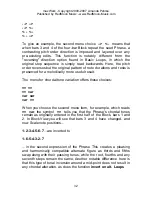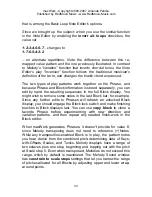
maxWerk - Copyright 2000-2007 Amanda Pehlke
Published by RedMoon Music - www.RedMoon-Music.com
29
If all of this seems like a lot to stay on top of, let's outline the
possibilities of composing purely by trial-and-error, using live scalic
transposing from the computer's QWERTY keyboard. Transposing
can trigger arpeggiated feedback if maxWerk is not playing, or it can
alter looping patterns in play. To trigger Tonic transpositions with a
matching (+)Note, use the numeric keypad or the number keys 1-2-
3-4-5-6-7 in the top row. The Arpeggiator sounds chordal tones
over two octaves on key presses and key releases, and the tones
when you press and release these keys are the same. Press one of
the keys Q-W-E-R-T-Y-U, which represent only (+)Notes 1 though 7,
and the (+)Note transposes independently from the last value
transmitted by the press of a number key.
Release the (+)Note key, and the (+)Note defaults; in other words,
maxWerk applies to it a step value that matches the last Tonic. With
the transpose function disabled and stored data bypassed, you can
trigger (+)Notes from the Q-W-E-R-T-Y-U keys just after you trigger
Tonics from the number keys, and make harmonious arpeggiated
chord changes. You can also do this while listening to your entered
patterns with the Transposer disabled and maxWerk playing. When
maxWerk is not playing, a toggling key command turns off the
Arpeggiator if you don't want to hear it.
The up and down keyboard arrows shift the Transposing Key (not
the Global Offset) by half-steps, and the lower left section of the
Main Screen always keeps you informed about the current Tonic,
(+)Note, Scale, and Key, and any Global Offset amount in effect.
With the Transpose function disabled, you can make changes of
Scale by means of the buttons in the Scales window if you wish.
Because of the tight timing required to do this with maxWerk
running, we don't recommend trying to manually shift everything at
once to do a live MIDI-driven performance. As long as maxWerk
sends note patterns, it may as well handle Transposer patterns for
you too.
We have seen now that an underlying principle of maxWerk is to let
you build songs in a premeditated or serendipity-driven combination
of any or all transposition types, slipping in a new set of changes
whenever you please, with any or all types taking effect at once. It




